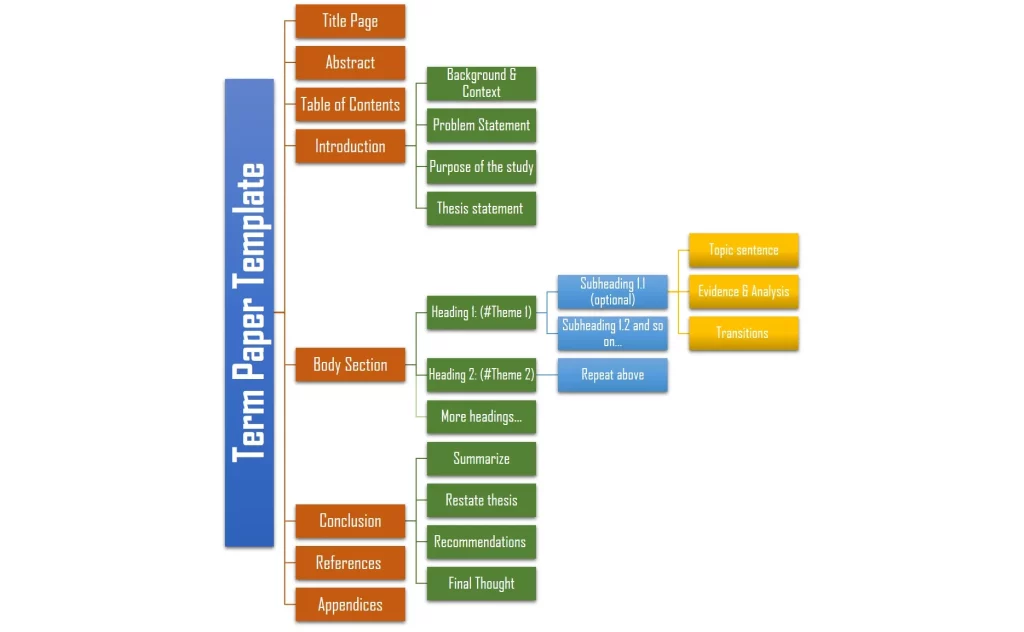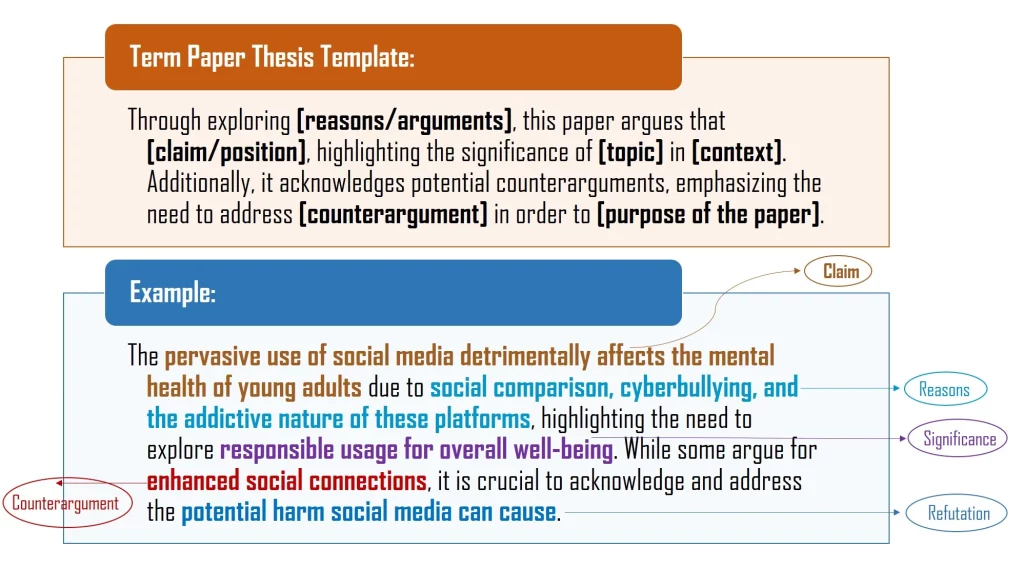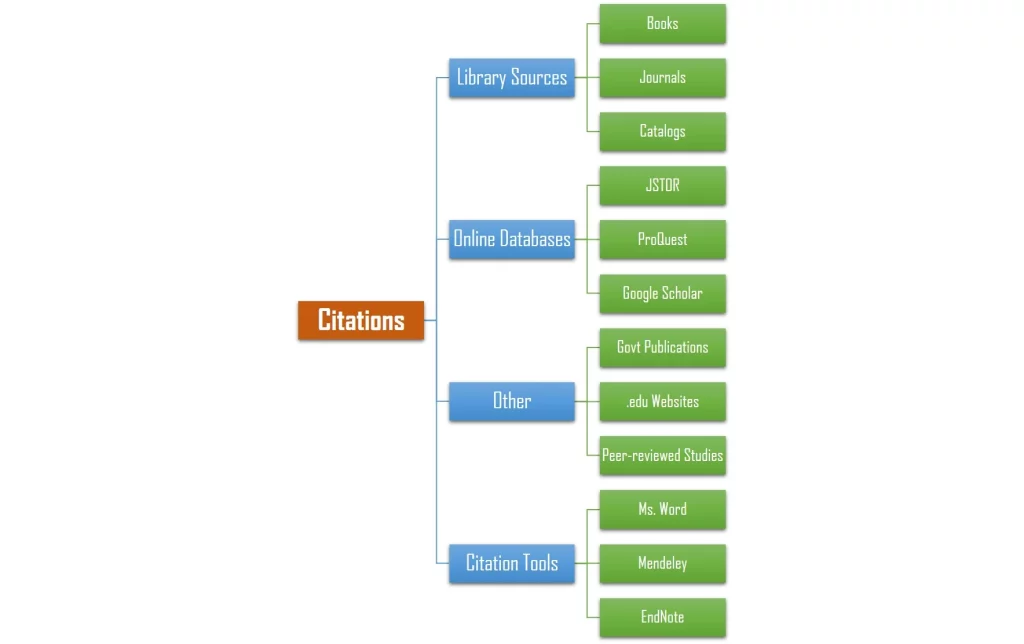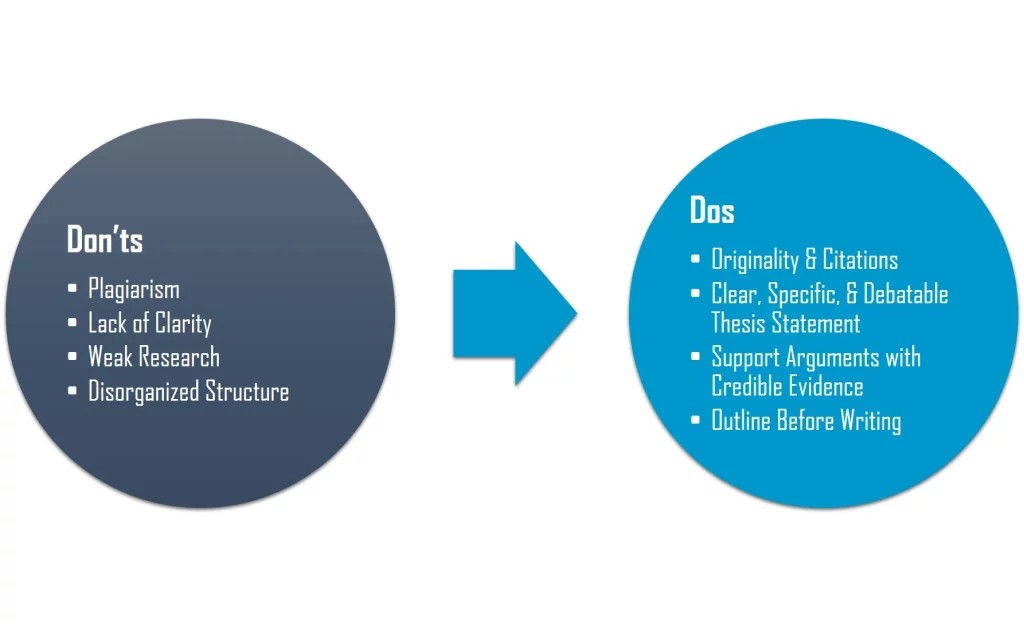
A term paper is a research-based academic essay that students typically write at the end of a semester or term as part of their coursework. It is a substantial written assignment that requires students to explore a specific topic in depth and demonstrate their understanding of the subject matter.
Here are sample term papers for students:
General Format
- Title Page:
- Abstract (if required): A brief summary of the paper’s main points and findings (usually 150-250 words).
- Table of Contents (if the paper is lengthy): List of sections and subsections with page numbers for easy navigation.
- Introduction:
- Multiple Body Paragraphs (Organized According to Major Themes):
- Conclusion:
- References (or Bibliography):
- Appendices (if needed): Supplementary material, such as charts, graphs, or additional data
It’s important to follow any specific formatting and citation style guidelines provided by your instructor. The length and detail of each section can vary based on the assignment’s requirements, so it’s essential to carefully read and follow the instructions given by your instructor for your specific term paper.
Steps on How to Write
- Select a Topic:
- Conduct Research:
- Create an Outline:
- Craft a Strong Thesis Statement:
- Start Writing in the Following Order:
- Begin writing your term paper, starting with the introduction. In the introduction, provide context, engage the reader’s interest, and clearly state your thesis.
- Body Paragraphs: Next, develop and explore each theme under a suitable heading. Use subheadings to extrapolate on key supportive points.
- Conclusion: Summarize the main points of your paper and restate your thesis. Discuss the implications of your research, its significance, and any potential areas for future study.
- References: Compile a list of all the sources you cited in your paper. Ensure proper citation style (e.g., APA, MLA, Chicago) and accurate bibliographic information.
- Appendices (if needed): If your paper includes supplementary material, such as charts, graphs, surveys, or extensive data, place them in appendices for reference.
- Revise and Edit:
- Formatting and Title Page:
- Final Review: Carefully review your term paper one last time to ensure it meets all the assignment’s criteria and is well-structured.
- Submission: Submit your term paper according to your instructor’s instructions or course requirements.
Writing a term paper is a rigorous process that requires careful planning, research, and attention to detail. It’s important to start early, seek help or feedback when needed, and adhere to the specified formatting and citation style.
Choosing a Suitable Topic
- Understand the Assignment: Start by carefully reading the assignment guidelines provided by your instructor. Pay attention to any specific requirements or constraints, such as the length of the paper, formatting, and due date.
- Identify Your Interests: Select a topic that genuinely interests you. Writing about a subject you are passionate about will make the research and writing process more enjoyable and engaging.
- Consider the Assignment’s Purpose: Think about the purpose of the term paper. Is it meant to inform, persuade, analyze, or explore a particular topic? Your chosen topic should align with this purpose.
- Narrow or Broad? Determine whether you should choose a broad or narrow topic. A broad topic may require more in-depth research, while a narrow one may be more focused and specific.
- Do Some Preliminary Research: Conduct initial research to see what has already been written on the topic. This will help you understand the existing literature and identify potential research gaps or areas where you can contribute new insights.
- Brainstorm Ideas: Brainstorm a list of potential topics related to your course or the assignment. Consider various angles, perspectives, and questions you find interesting.
- Test the Feasibility: Evaluate the feasibility of each topic. Ensure that you have access to the necessary resources, such as books, articles, and databases, to research the topic effectively.
- Consider the Audience: Think about your target audience, which may be your instructor or peers. Choose a topic that is relevant and engaging for your intended readers.
- Debate and Controversy: Topics that have debates, controversies, or multiple viewpoints can make for engaging term papers. They allow you to analyze different perspectives and make a compelling argument.
- Ask for Input: Discuss your ideas with your instructor or peers. They can provide valuable feedback and help you refine your topic.
- Craft Your Thesis: Once you’ve chosen a topic, develop a clear and specific thesis statement that articulates the main argument or purpose of your paper. Your thesis will guide your research and writing.
- Be Flexible: Be prepared to adjust your topic or thesis as you delve deeper into your research and discover new information or perspectives.
In summary, the key to identifying an excellent topic for a term paper is to choose a subject that interests you, is relevant to your assignment’s purpose, and has adequate research materials available. The choice of topic will significantly impact your overall experience with the term paper. Remember that effective planning, organization, and adherence to academic integrity principles will contribute to your success in completing a term paper.
Crafting a Strong Thesis Statement for Your Term Paper
- Choose a Clear and Specific Topic: Begin by selecting a specific topic or issue that you want to address in your term paper. The more focused your topic, the easier it will be to craft a strong thesis.
- Identify Your Main Argument: Your thesis statement should present a concise argument or position on the chosen topic. It should make a clear and debatable claim. Avoid vague or broad statements.
- Consider the Scope of Your Paper: Think about the scope and length of your term paper. Ensure that your thesis statement is manageable within the paper’s constraints. It should be neither too narrow nor too broad.
- Review Existing Literature: Conduct some preliminary research to understand what published authors and notable scholars have said about your topic. This can help you identify gaps or areas of controversy that your thesis can address.
- Make It Specific and Unique: Avoid general statements or well-accepted facts. Your thesis should provide a fresh perspective or a specific argument that contributes to the existing knowledge on the topic.
- Ensure It’s Debatable: A strong thesis statement should be something that others may disagree with or have different opinions about. Avoid statements that are self-evident or universally accepted.
- Use Precise Language: Be clear and specific in your language. Avoid vague or ambiguous terms. Your thesis should be concise and to the point.
- Test Your Thesis: Share your thesis statement with others, such as peers or your instructor, to get feedback and ensure it’s clear and compelling.
- Revise as Needed: Don’t be afraid to revise your thesis statement as you progress with your research and writing. It may evolve as you gain a deeper understanding of the topic.
- Incorporate It into Your Introduction: Your final thesis statement should be included in the introduction of your term paper to inform readers of the central argument and purpose of your paper.
Term Paper Thesis Statement Template

Here’s a basic template that you can use as a starting point. Customize the template to fit your topic and the specific requirements of your assignment.
“In [your topic], this paper argues that [your argument or main point] because of [reason 1], [reason 2], and [reason 3].”
Let’s break down the template:
- In [your topic]: This part introduces the subject of your term paper. Replace “[your topic]” with the specific topic you’re addressing.
- This paper argues that: This signals that your thesis statement is presenting an argument or a main point. You can modify this phrase to suit your writing style, but it’s important to be clear about your intention to argue or prove something.
- [Your argument or main point]: Insert your main argument or the central point of your paper here. This should be a clear and specific statement that you aim to support in your paper.
- Because of [reason 1], [reason 2], and [reason 3]: Following your main argument, briefly list the primary reasons or evidence that support your thesis. These reasons will guide the structure of your paper and provide a preview of your key supporting points.
Term Paper Thesis Statement Example
Here’s an example of a strong thesis statement for a term paper on the topic of climate change:
“Human activities, particularly the burning of fossil fuels and deforestation, are the primary drivers of global climate change, and urgent action is required to mitigate the devastating environmental, economic, and social consequences of this phenomenon.”
This thesis statement is strong because it:
- Is Specific: It clearly identifies the topic (climate change), the primary causes (human activities), and the consequences (environmental, economic, and social) that will be discussed in the paper.
- Is Debatable: While there is scientific consensus on human-induced climate change, there are still debates about the extent of its impact and the urgency of action, making it a suitable topic for discussion and argument.
- Provides a Clear Focus: It establishes the central argument and purpose of the paper, which is to explore the causes and consequences of climate change and advocate for action.
Remember that a strong thesis statement is essential for guiding your research and providing a clear direction for your term paper. It should be well-crafted, specific, debatable, and relevant to the topic you’re addressing in your paper.
Conducting Research: Finding Suitable Citations for Your Term Paper

Finding suitable citations for your term paper involves conducting research and identifying credible sources to support your arguments and provide evidence for your claims. Here’s how and where to find suitable citations:
- Library Resources:
- Online Databases:
- Academic Journals:
- Websites of Educational Institutions: Websites of reputable universities and educational institutions often host research publications, theses, and reports that can be valuable sources.
- Government Publications: Government websites, such as those of federal agencies and research organizations, offer reports and data on a variety of topics.
- Citation Tools: Citation management tools like Zotero, Mendeley, or EndNote can help you organize and format your citations.
- Reference Lists and Bibliographies: Check the reference lists and bibliographies of articles, books, and other sources you find. They can lead you to additional relevant materials.
- Ask Your Instructor: Your instructor or professor can recommend specific sources or provide guidance on where to find suitable citations for your paper.
In summary, the key to finding suitable citations for a term paper is to conduct thorough research using a variety of credible sources, including libraries, online databases, academic journals, and government publications. Prioritize peer-reviewed sources and critically evaluate each source for relevance and credibility. Be diligent in citing your sources correctly using the citation style required for your term paper (e.g., APA, MLA, Chicago) to avoid plagiarism and ensure proper academic integrity.
Developing Body Paragraphs in a Term Paper
- Thematic Sections: The body is usually divided into thematic sections or headings, each addressing a specific aspect of your topic or a subtopic related to your thesis. The number and titles of these sections will depend on the structure of your paper and the requirements of your assignment.
- Supporting Paragraphs: Within each section, you’ll have supporting paragraphs. Each paragraph should focus on a specific point, argument, or idea. Begin with a topic sentence that introduces the main point of the paragraph and then provide evidence, examples, or analysis to support that point.
- Use of Evidence: Incorporate evidence from your research, such as quotes from authoritative sources, statistics, data, and scholarly literature. Ensure that your evidence supports and strengthens your arguments.
- Analysis and Interpretation: Don’t just present evidence; analyze and interpret it. Explain the significance of the evidence in relation to your thesis and the larger context of your topic. Connect the dots for your reader and show how the evidence supports your claims.
- Transitions: Use transitional sentences and phrases to guide your reader through the logical flow of your paper. Transitions help connect ideas between paragraphs and sections and create a cohesive narrative.
- Counterarguments (if applicable): If your topic allows for it, consider addressing counterarguments or opposing viewpoints within the body of your paper. This demonstrates your ability to engage with and respond to different perspectives.
- Synthesis: Synthesize information from various sources and your analysis to build a comprehensive and nuanced understanding of your topic. Show how different pieces of information fit together to support your thesis.
- Subheadings (if needed): Depending on the length and complexity of your paper, you may use subheadings within each section to further organize your content and make it more reader-friendly.
- Consistency: Maintain a consistent and clear writing style throughout the body of your paper. Ensure that your arguments flow logically and that there is a clear progression from point to point.
- Cohesion: Ensure that there is cohesion between the introduction, body, and conclusion. The body should fulfill the promises made in the introduction and prepare the reader for the conclusions drawn in the final section.
Remember to use citations and references to give credit to the sources you use within the body of your paper. Careful organization, clarity, and strong argumentation are key to writing an effective and well-structured body for your term paper.
7 Major Mistakes to Avoid

Avoiding common mistakes in a term paper is crucial for producing a high-quality piece of academic writing. Here are seven major mistakes and tips on how to avoid them:
- Plagiarism:
- Lack of Clarity and Focus:
- Weak Research:
- Disorganized Structure:
- Wordiness and Redundancy:
- Grammar and Spelling Errors:
- Ignoring Instructions:
In addition to these tips, it’s important to start your term paper well in advance, allowing time for research, writing, and revision. Seek feedback from peers or your instructor, and use writing resources available at your educational institution, such as writing centers or style guides. Taking these steps will help you avoid common mistakes and produce a more polished and effective term paper.
Frequently Asked Questions (FAQs)
-
How does a term paper differ from a research paper?
- A term paper and a research paper are similar in that they both involve research and writing, but they differ in scope and purpose. A term paper is usually assigned at the end of a term or semester and typically covers a specific topic or subject studied during that term. Research papers, on the other hand, are more comprehensive and often involve original research or a deeper exploration of a broader subject.
- Term papers may be more focused on summarizing and synthesizing existing knowledge, while research papers aim to contribute new insights or knowledge to a field.
-
What is the typical structure and format of a term paper?
- A typical term paper structure includes:
- Title Page
- Abstract (if required)
- Table of Contents (if lengthy)
- Introduction
- Literature Review
- Methodology (if applicable)
- Discussion
- Conclusion
- References
- Appendices (if needed)
- The formatting and citation style (e.g., APA, MLA, Chicago) may vary depending on your instructor’s guidelines.
- A typical term paper structure includes:
-
How do I start the research process for my term paper?
- Start by understanding the assignment and choosing a suitable topic.
- Then, conduct preliminary research to identify key sources and gather information.
- Create an outline to organize your thoughts and research questions.
- Utilize library resources, online databases, and academic journals for in-depth research.
-
What are the best sources to use for research, and how can I access them?
- The best sources include academic books, peer-reviewed articles, reputable websites, government publications, and primary sources.
- Access them through your university’s library, online databases, interlibrary loans, and open-access repositories.
- Librarians can guide you to relevant sources.
-
How can I avoid plagiarism when writing my term paper?
- Avoid plagiarism by citing sources properly, using quotation marks for direct quotes, and paraphrasing correctly.
- Keep meticulous notes, use plagiarism detection software if available, and be aware of your institution’s plagiarism policies.
- Understand the rules for citation styles.
-
What citation style should I use for my term paper, and how do I format it correctly?
- The citation style depends on your academic discipline and instructor’s preference. Common styles include APA, MLA, Chicago, and more.
- Consult style guides or online resources for specific formatting rules and citation examples.
-
What is the ideal length for a term paper, and how many pages should it be?
- The length can vary, but a typical term paper may be 10-20 pages, double-spaced, excluding references and appendices.
- Follow your instructor’s guidelines regarding length.
-
What should I include in the introduction and conclusion of my term paper?
- In the introduction, provide background information, state your thesis, and outline the scope of your paper.
- In the conclusion, summarize the key points, restate the thesis, and discuss the implications of your findings or arguments.
-
How can I effectively outline and organize my thoughts and research findings?
- Create an outline that follows your paper’s structure. Organize ideas logically, use headings and subheadings, and ensure a clear flow from one section to the next.
- Revise and edit for clarity and coherence.
-
What is the role of an abstract in a term paper, and how do I write one?
- An abstract is a concise summary of your paper’s main points, typically 150-250 words.
- It provides a brief overview of the topic, research question, methodology, key findings, and conclusion.
- Write it after completing the paper.
-
How can I balance my time effectively to meet the deadline for my term paper?
- Create a timeline with milestones, allocate specific time slots for research, writing, and revision, and adhere to a schedule.
- Avoid procrastination and seek help or extensions if needed.
-
Should I seek feedback from my instructor or peers during the writing process?
- Yes, seeking feedback is valuable. Consult your instructor for clarification on the assignment.
- Peer review can provide insights, and constructive criticism can improve the quality of your paper.
-
What resources or services are available on campus or online to help me with my term paper?
- Universities often offer writing centers, academic support services, and library resources to assist with research and writing.
- Online resources, writing guides, and citation management tools are also available.
-
What is the process for revising and proofreading my term paper before submission?
- After completing your draft, set it aside for a while, then revise for content and structure.
- Proofread for grammar, spelling, and formatting errors.
- Consider seeking feedback from peers or professional editing services.
-
How will my term paper be graded, and what are the key criteria for evaluation?
- Your paper will be evaluated based on the quality of research, organization, clarity of writing, adherence to instructions, originality, citation accuracy, and the strength of arguments.
- Specific grading and scoring points can be found in the rubric which can be accessed below the assignment’s instructions in your academic institution’s portal.
-
Can I request an extension if I’m unable to meet the deadline for my term paper?
- Depending on your circumstances, you may be able to request an extension due to illness, family emergencies, or other valid reasons.
- Contact your instructor as early as possible to discuss your situation.
-
What are the consequences of academic dishonesty in term papers?
- Academic dishonesty, such as plagiarism, can result in serious consequences, including failing the assignment, the course, or academic disciplinary actions.
- Understand your institution’s policies and the importance of academic integrity.
-
How can I manage stress and anxiety associated with working on a term paper?
- Break the task into smaller, manageable steps.
- Take regular breaks, maintain a healthy work-life balance, and seek support from friends, family, or campus resources if you feel overwhelmed.
- Practicing time management and stress reduction techniques can help as well.
In conclusion, the key to writing a successful term paper is thorough planning, which includes choosing a focused topic, conducting comprehensive research, organizing your thoughts, and adhering to the assignment guidelines and citation requirements. Effective time management, clear writing, and careful proofreading are also crucial for success.
